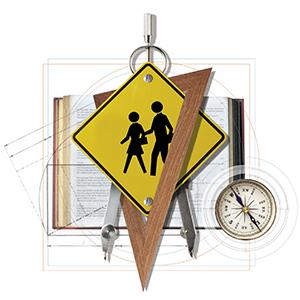It’s safe to say that as a black male teacher of high school engineering, I am considered an anomaly. If you dig through all of the statistics about black male teachers nationwide and compare them with the number of science, technology, engineering, and mathematics (STEM) teachers of color, you will find very few teachers like me.
My uniqueness is predicated on a few heartbreaking numbers. The 2012–2013 high school graduation rate for black males was 59 percent, compared with 80 percent for white males.1 The college graduation rate for black males is also abysmal: of students entering college in 2008, only 35 percent of black males completed their degrees within six years, compared with 60 percent of white males.2 Given these statistics, it’s hardly surprising that only 2 percent of the entire teaching population is comprised of black males.3 And while 16 percent of public school students are black, of students who earned bachelor’s degrees in STEM fields in 2013–2014, just 4 percent were African American males.4
Keeping in mind all of the socioeconomic and other factors that contribute to these statistics, simple math suggests that a teacher like me has a very slim chance of existing. And yet here I am, a black male high school teacher of science in Baltimore City Public Schools.
* * *
I’ve had my share of twists and turns in my educational trajectory. I was raised in Columbia, South Carolina, where I attended an elementary school led by a black male principal (another anomaly). He and I spent many a day together, so much so that I even had my own desk in his office. Let’s just say I was a very inquisitive and energetic child.
The passing of years and shifting perspectives have certainly changed my understanding as to why I spent so much time in the principal’s office. I remember for the most part being a happy child but very different from my classmates and my teachers. I was one of the few black students at my school, and my family was not as affluent as the families of my peers. As a child, I could not grasp entirely how socioeconomic differences affected my relationships with my classmates; however, I recall seeing the houses and cars of my classmates’ parents, and I knew we were from different worlds.
In class, I recall having difficulty understanding the need to follow certain directions or why I had to wait to do things. As an enthusiastic student, I wanted to learn on my own terms and in my own ways. I wanted to move faster at times, but at other times I needed to move more slowly. I usually learned quickly, and my pace rarely matched that of my classmates. Once I felt I had mastered a subject or a concept, I had trouble staying patient until my peers caught up with me. But instead of being placed in a more challenging environment, I was often called a “difficult child.” Even as a young child, the label stung.
It wasn’t until I became a teacher that I understood my experience was not unique. My story is similar to the stories of many other black males in schools with precious few black male teachers.*
Only recently have researchers and policymakers decried the significant numbers of black boys being labeled disruptive and/or hyperactive, and the dearth of these students being accepted into honors and/or gifted programs. These negative labels, compounded with the lack of opportunities for black boys to flex their mental prowess, generate a cycle of referrals and suspensions that lower students’ self-esteem and impede student learning.†
In a system that has too often viewed black males negatively, these students especially need educational role models to help guide them.
When I was a child, my principal was that role model for me. He knew all the right things to say to keep me on track. At the time, I felt he understood me in ways my other teachers never did. Throughout the rest of my elementary and secondary education, I didn’t have another black male leader or teacher until Benedict College, a historically black college in Columbia, South Carolina, where I majored in physics. I chose the college because I wanted the experience of having faculty members who were black like me.
There, I excelled and graduated with honors in biological and physical sciences. It was a long way from the principal’s office. But that principal was one of the major reasons I later went to Johns Hopkins University to pursue a master’s degree in urban education and administration.
Earning my advanced degree in education prompted me to think about my mediocre performance in primary and secondary education and my eventual college success. In high school, I was a middle-of-the-road student who graduated in the middle of my high school class of 300-plus students.
Despite my average grades, I loved science and math; I even read science and math books for fun. I conducted physics experiments at home daily, and I was intrigued by engineering. Yet, my guidance counselor continually recommended I take lower-level, less challenging classes, I assume because of my athletic ability (I played football, wrestled, and ran track). I honestly wanted to believe that was the logic for not encouraging me to take honors classes—which might have only four black students in a class of 30. I was lost in a system that was fine with me being lost.
But a summer experience at Ohio University in Athens, Ohio, opened up a world of possibilities for me, and I wish all students had access to such a life-changing opportunity. I was able to attend a program focused on encouraging minority male high school students who were interested in engineering to pursue careers in education. For the first time, I was around other students of color who shared a love of science and math.
As a black male teacher in a STEM field, I believe that getting more teachers like me in classrooms today boils down to expectations and access. The truth is that students who are held to higher expectations reach higher levels of success. “Who Believes in Me? The Effect of Student-Teacher Demographic Match on Teacher Expectations,” a study published last year by researchers at American University and Johns Hopkins University, bears this out.
The study brought to light some long overlooked issues on the impact of race and educational expectations. In a blog post explaining the findings, one of the study’s authors, Seth Gershenson, writes that “when a black student is evaluated by one black teacher and by one non-black teacher, the non-black teacher is about 30 percent less likely to expect that the student will complete a four-year college degree than the black teacher.”5
“These results are not meant to, nor should they, demonize or implicate teachers,” Gershenson continues. “Biases in expectations are generally unintentional and are an artifact of how humans categorize complex information.”‡ The study’s findings simply “highlight the need to better understand how teachers form expectations, what types of interventions can reduce or eliminate biases in teacher expectations, and perhaps most importantly, how such expectations and biases affect the long-run student outcomes of ultimate import.”6
Because I am a black male educator who teaches at an urban high school where almost all of my students receive free or reduced-price meals, I understand the importance of providing access to additional opportunities and supports, as well as to images of success. Students cannot imagine future educational and career opportunities if they’ve never seen them firsthand.
That’s why I never say to my students, “Your only limit is your imagination.” To me, the old cliché is inherently biased. Many of my students come from families with so few educational or financial resources that their imaginations are understandably confined by their experiences. And for many black male students in particular, those experiences have been especially limited.
However, in recent years there has been a shift in thinking among young black males regarding careers they can pursue. Thanks largely to the success and popularity of President Obama, young black students are seeing more black professionals in increasingly prominent roles, and as a result, they are beginning to consider pursuing such roles for themselves.
While Obama’s presence alone has been inspiring, his My Brother’s Keeper program has become possibly the biggest “call to action” in support of black males.
Just as important, U.S. Secretary of Education John King—also a black man—has emphasized the need for more educators of color to help change the trajectory of our black boys. King has shared publicly that the issue is personal for him. In May, I had the distinct honor of introducing him at this year’s National Summit on Teacher Diversity in Washington, D.C. The audience and I listened to him describe the profound impact his educators had on his educational path. He stressed in no uncertain terms how important a strong, diverse teaching force is to ensuring our students engage in their learning and personal growth.
Other males of color, such as public intellectuals, can make such an impact as well. For instance, the famous astrophysicist Neil deGrasse Tyson, who is of African American and Puerto Rican descent, had a powerful effect on me. Though I never met him, I could really connect with him—something clicked—when he talked about science on television.
That same connection can occur in the classroom. An educator of color can give students of color—especially black males—a concrete image of possibility. To turn that possibility into reality, we must ultimately change the conversation about who’s in education—and change who’s in the conversation about education.
Harry F. Preston V teaches engineering and cochairs the career and technical education department at Edmondson-Westside High School in the Baltimore City Public Schools district. An alumnus of Teach for America, he is the head of the Baltimore City Project Lead the Way Engineering Design and Development Symposium, and he participated in the AFT’s Teacher Leaders Program. He is also the executive vice president of vocational education for the Baltimore Teachers Union.
*For more on the importance of black males in the classroom, see “The Need for More Teachers of Color” in the Summer 2015 issue of American Educator. (back to the article)
†For more on school discipline and related statistics, see “From Reaction to Prevention” in the Winter 2015–2016 issue of American Educator. (back to the article)
‡For more on biases, see “Understanding Implicit Bias” in the Winter 2015–2016 issue of American Educator. (back to the article)
Endnotes
1. Schott Foundation for Public Education, Black Lives Matter: The Schott 50 State Report on Public Education and Black Males (Cambridge, MA: Schott Foundation for Public Education, 2015), 7.
2. “Graduation Rate from First Institution Attended for First-Time, Full-Time Bachelor’s Degree-Seeking Students at 4-Year Postsecondary Institutions, by Race/Ethnicity, Time to Completion, Sex, Control of Institution, and Acceptance Rate: Selected Cohort Entry Years, 1996 through 2008,” in National Center for Education Statistics, Digest of Education Statistics, 2015, table 326.10.
3. “Number and Percentage Distribution of Teachers in Public and Private Elementary and Secondary Schools, by Selected Teacher Characteristics: Selected Years, 1987–88 through 2011–12,” in National Center for Education Statistics, Digest of Education Statistics, 2014, table 209.10.
4. “Enrollment and Percentage Distribution of Enrollment in Public Elementary and Secondary Schools, by Race/Ethnicity and Region: Selected Years, Fall 1995 through Fall 2025,” in National Center for Education Statistics, Digest of Education Statistics, 2015, table 203.50; and “Number and Percentage Distribution of Science, Technology, Engineering, and Mathematics (STEM) Degrees/Certificates Conferred by Postsecondary Institutions, by Race/Ethnicity, Level of Degree/Certificate, and Sex of Student: 2008–09 through 2013–14,” in National Center for Education Statistics, Digest of Education Statistics, 2015, table 318.45.
5. Seth Gershenson, “The Alarming Effect of Racial Mismatch on Teacher Expectations,” Brown Center Chalkboard (blog), Brookings Institution, August 18, 2015, www.brookings.edu/blogs/brown-center-chalkboard/posts/2015/08/18-teacher-expectations- gershenson.
6. Gershenson, “Alarming Effect.”


